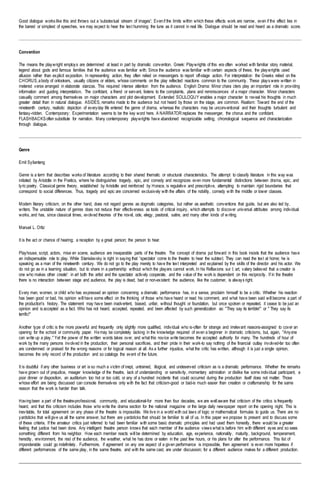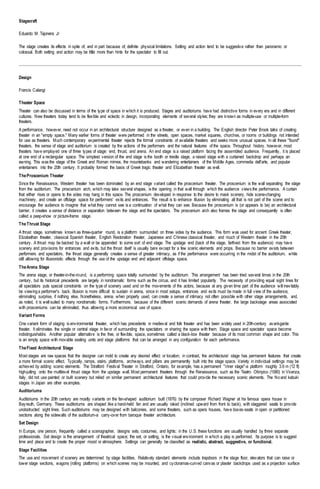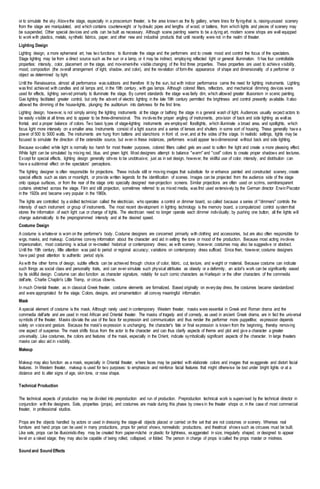This document provides an overview of different play genres and theatrical terms:
- Comedies are designed to be humorous and use elements like wit, unusual characters, and mistaken identities. Common genres include farces, satires, and restoration comedies.
- Tragedies have darker themes like death and contain a tragic flaw that leads to the protagonist's downfall.
- Other genres include historical plays, musical theatre, theatre of cruelty, and theatre of the absurd.
- The document also defines key terms like "play" and discusses Shakespeare's plays which fall into categories of tragedies, comedies, histories, and romances.
![Play (theatre)
A play is a form of literature written by a playwright, usually consisting of dialogue between characters, intended
for theatrical performance rather than just reading. Plays are performed at a variety of levels, from Broadway, Off-
Broadway, regional theater, to Community theatre, as well as University or school productions. There are rare dramatists,
notably George Bernard Shaw, who have had little preference whether their plays were performed or read. The term "play"
can refer to both the written works of playwrights and to their complete theatrical performance.[1
Genres
Comedy[
Comedies are plays which are designed to be humorous. Comedies are often filled with witty remarks, unusual characters, and strange circumstances. Certain
comedies are geared toward different age groups. Comedies were one of the two original play types ofAncient Greece, along with tragedies. An example of a
comedy would be William Shakespeare's play "A Midsummer Night's Dream," or for a more modern example the skits from "Saturday Night Live".
Farce
A generally nonsensical genre of play, farces are often overacted and often involveslapstick humor. An example of a farce includes William Shakespeare's play The
Comedy of Errors, or Mark Twain's play Is He Dead?.
Satirical
A satire play takes a comic look at current events people while at the same time attempting to make a political or social statement, for example pointing
out corruption. Anexample of a satire would be Nikolai Gogol's The Government Inspector and Aristophanes' Lysistrata. Satire plays are generally one of the most
popular forms of comedy, and often considered to be their own genre entirely.
Restoration Comedy
This is a genre that explored relationships between men and women, and was considered risqué in its time. Characters featured in restoration comedy included
stereotypes of all kinds, and these same stereotypes were found in most plays of this genre, so much so that most plays were very similar in message and content.
However, since restoration comedy dealt with unspoken aspects of relationships, it created a type of connection between audience and performance that was more
informal and private.
It is commonly agreed that restoration comedy has origins in Molière’s theories of comedy, but differs in intention and tone.[5] The inconsistency between restoration
comedy’s morals and the morals of the era is something that often arises during the study of this genre. This may give clues as to why, despite its original success,
restoration comedy did not last long in the seventeenth century. However, in recent years, it has become a topic of interest for theatre theorists, whohave been
looking into theatre styles that have their own conventions of performance.[6]
Tragedy
These plays contain darker themes such as death and disaster. Often the protagonist of the play has a tragic flaw, a trait which leads to their downfall. Tragic plays
convey all emotions, and have extremely dramatic conflicts. Tragedy was one of the two original play types of Ancient Greece. Some examples of tragedies include
William Shakespeare's Hamlet, and also John Webster's play The Duchess of Malfi.[2]
Historical
These plays focus on actual historical events. They can be tragedies or comedies, but are often neither of these. History as a separate genre was popularized
by William Shakespeare. Examples of historical plays include Friedrich Schiller's Demetrius and William Shakespeare's King John.[7]
Musical Theatre
Ballad opera, a popular theatre style at the time, was the first style of musical to be performed in the American colonies. The first musical of American origin was
premiered in Philadelphia in 1767, and was called “The Disappointment”, however, this play never made it to production. Around the 1920s, theatre styles were
beginning to be defined more clearly. For musical theatre, this meant that composers gained the right to create every song in the play, and these new plays wereheld
to more specific conventions, such as thirty-two-bar songs. When the Great Depression came, many people left Broadway for Hollywood, and the atmosphere of
Broadway musicals changed significantly. A similar situation occurred during the 1960s, when composers were scarce and musicals lacked vibrancy and
entertainment value.
By the 1990s, there were very few original Broadway musicals, as many were recreations of movies or novels.
Musical productions have songs to help explain the story and move the ideas of the play along. They are usually accompanied by dancing. Musicals can be very
elaborate in settings and actor performances. Examples of musical productions include Wicked and Fiddler on the Roof.
Theatre of Cruelty
This theatre style originated in the 1940s when Antonin Artaud hypothesized about the effects of expressing through the body as opposed to “by socially conditioned
thought.” In 1946, he wrote a preface to his works in which he explained how he came to write what and the way he did.
Above all, Artaud did not trust language as a means of communication. Plays within the genre of theatre of cruelty are abstract in convention and content. Artaud
wanted his plays to have an effect and accomplish something. His intention was to symbolize the subconscious through bodily performances, as he did not believe
language could be effective. Artaud considered his plays to be an enactment rather than a re-enactment, which meant he believed his actors were in reality, rather
than re-enacting reality.
His plays dealt with heavy issues such as patients in psychwards, and Nazi Germany. Through these performances, he wanted to “make the causes of suffering
audible”, however, audiences originally reacted poorly, as they were so taken aback by what they saw. Much of his work was banned in France at the time.
Artaud did not believe that conventional theatre of the time would allow the audience to have a cathartic experience and help heal the wounds of World War II. For
this reason, he moved towards radio-based theatre, in which the audience could use their imagination to connect the words they were hearing to their body. This
made his work much more personal and individualized, which he believed would increase the effectiveness of portraying suffering.[9]
Theatre of the Absurd
Theatre of the Absurd: This genre generally includes metaphysical representations of existential qualms and questions. Theatre of the absurd denies rationality, and
embraces the inevitability of falling into the abyss of the human condition. Instead of discussing these issues, however, theatre of the absurd is a demonstration of
them. This leaves the audience to discuss and question the content of the play for themselves.
One of the main aspects of theatre of the absurd is the physical contradiction to language. Oftentimes, the dialogue between characters will directly oppose their
actions.
Famous playwrights within this genre include Beckett, Sartre, Ionesco, Adamov, and Genet.](https://image.slidesharecdn.com/creativewriting-211126104152/85/Creative-writing-1-320.jpg)

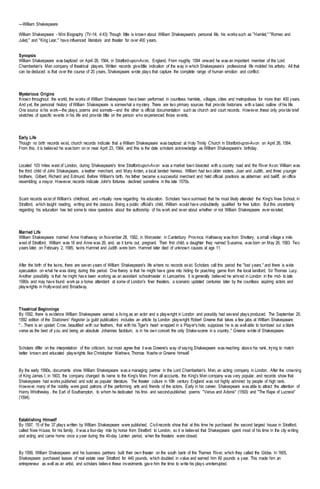
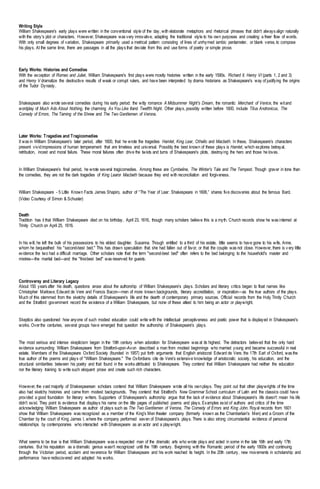

![Confidant: A character that lends an ear and gives his input to usually the protagonist is a confidant. This type of character is most commonly a closest friend or
trusted servant of the main character, who serves as a device for revealing the mind and intention of the main character. The confidant’s inputs are revealed only to
the audience and not to the other characters in the play.
Example: In Hamlet, Horatio is the confidant.
Stock characters: A stereotypical character who is not developed as an individual but as a collection of traits and mannerisms supposedly shared by all members of
a group. These characters are easily recognized by audience due to their recurrent appearance and familiar roles.
Example: A comic, a servant, a fool, a coward, a crooked stepmother, and wicked witch.
Each character is distinct from the other and must have their own peculiar personality, background, and beliefs. The mannerisms and use of language too may differ.
The way the characters in the play are treated by the playwright is important to the outworking of the play.
2. Dialogue:
The words uttered by characters in a play forms a dialogue. The dialogue reveals the plot and characters of the play. What is spoken must be suitable to the situation
and the role of the character.
Things that are said on stage may take on greater worth or typical qualities than the same things said in everyday speech. Good dramatic speech involves a proper
construction of words spoken in the appropriate context. It also involves saying what is not uninviting or what is obvious straight away.
Good dialogue sheds light on the character speaking and the one spoken about, and aids in the furtherance of the plot.
Dialogue may take various forms:-
An exchange between two or more characters.
Titinius. These tidings will well comfort Cassius.
Messala. Where did you leave him?
Titinus. All disconsolate,
With Pindarus his bondman, on this hill.
Messala. Is not that he lies upon the ground?
Soliloquy- A character that is typically alone on stage delivers a long speech which is called a soliloquy. Emotions and innermost thoughts of the
character are revealed in a soliloquy.
[They exit. ANTONY remains.]
ANTONY.
O, pardon me, thou bleeding piece of earth,
That I am meek and gentle with these butchers!
Thou art the ruins of the noblest man
That ever lived in the tide of times.](https://image.slidesharecdn.com/creativewriting-211126104152/85/Creative-writing-6-320.jpg)
![ Aside- This is spoken by a character to another character or to the audience but is not heard by the other characters on stage. Asides reveal what a
character is thinking or feeling.
Caesar.
Good friends, go in and taste some wine with me,
And we (like friends) will straightway go together.
Brutus (aside) .
That every like is not the same, O Caesar,
The heart of Brutus earns to think upon. [Exeunt.]
3. Plot:
The plot is events that occur in a story sequentially. Normally the introduction of the characters in the beginning of the play gives the audience an idea about what the
plot maybe. This information will enlighten the audience as to why characters behave the way they do and an incident maybe expected to surface that will create a
problem for the main characters.
As the action heightens, the characters encounter the problem and find themselves in trouble. The conflict in a plot may vary but nevertheless it forms the basis for
the plot. The conflict leads the characters from one incident to another unfolding the plot and increasing the suspense and excitement of the reader or viewer.
The turning point of the plot is called the climax when the outcome of the conflict takes place. The climax takes several forms. It may be a revelation of information or
it may be a decision or an action. It is the point where suspense no longer exists.
The plot is crucial for the success of a play.
4. Setting:
The setting and time in a play tell us where the story happened and the time it occurred.
The setting is very important because what usually happens in the play is influenced by it. Visual components of a setting maybe limited to a painted tree, a bridge, or
a hut, or it could be more elaborate. Shifts in time and space are often indicated by the actors through their speech and mov ements.
In setting, the lighting plays an important role for it shows an illusion of time. Lighting also may be used to focus on an action or stress the importance of an event.
Costumes and props too are involved in setting. Costumes are used to portray a character’s profession, status, ethnicity, age and so on.
Props are items used by actors on stage to create an atmosphere of the play. These can be simple writing materials, chairs and tables, flowers, thrones, blood-
soaked clothes, blankets, and beds and so on.
The effect created by the setting creates the mood for a theatrical spectacle.
5. Stage directions:
An audience is prompted to react by the movements or positions of the actors in a play. It can build up tension, trigger laughter, or shift the focus of the audience to a
different part of the stage.](https://image.slidesharecdn.com/creativewriting-211126104152/85/Creative-writing-7-320.jpg)
![To achieve this purpose, the writer communicates to the actors, director, and the rest of the crew in the play by means of stage directions.
He does this by means of short phrases, usually printed in italics and enclosed in parentheses or brackets. These directions describe the appearance and actions of
characters as well as the sets, costumes, props, sound effects, and lighting effects.
Stage directions may also include the characters’ body language, facial expressions, and even the tone of voice. Comments or remarks about the surroundings and
when a character enters or exits are also made in stage directions. Thus stage directions help us understand the feelings of the character and the mood of the story.
For movies and teleplays, camera instructions are provided.
Example:
HUCK. [Picks up a hard little sphere.] What's this?
JIM. Must a been in there a long time to coat it over so.
[JIM cuts open the sphere and hands HUCK a coin.]
HUCK. It's gold.
JIM. What sort of writing is that on it?
HUCK. Spanish...I think. This is a Spanish d'bloon, Jim, it's priate gold!
Why I reckon this fish could be a hundred years old. Do you reckon so, Jim?
JIM. [Nodding.] He go along on the bottom. Eat the little ones. Get older and older and bigger and bigger. He here before people come maybe. Before this was a
country. When there was nothing here but that big river...
[He grabs HUCK's arm.]
6. Theme:
The theme actually tells what the play means. Rather stating what happens in the story, the theme deals with the main idea within the story. Theme has been
described as the soul of the drama. The theme can either be clearly stated through dialogue or action or can be inferred from the entire performance. We shall
conclude plot and theme in drama should compliment each other and should be synchronized to give a complete output.
General themes are:
i. conflict--between two individuals
ii. conflict between man and a supernatural power
iii. conflict between the man and himself
Structure of Drama
Back to Top
Ancient Greek drama contained structural divisions and these gradually evolvedto a five part structure in drama. By the 16th century, Five Act plays were the order
of the day with any number of scenes in each act.
A traditional play thus came to be a FiveAct Play. What was the structure followed here?
Exposition or introduction
Rising Action
Climax
Falling Action
Denouement or conclusion
Exposition: This is the introduction of the play which provides important background information about the characters, setting, and the conflict they face or are about
to face. It may reveal an incident in a character’s past that has a bearing on the plot. The exposition leads the audience to follow through the rest of the story.](https://image.slidesharecdn.com/creativewriting-211126104152/85/Creative-writing-8-320.jpg)



